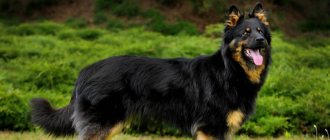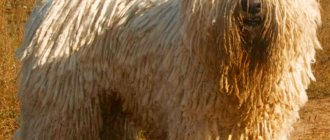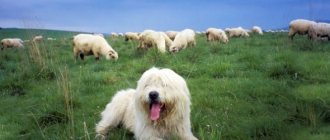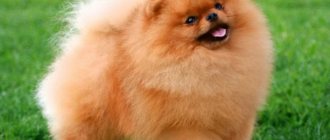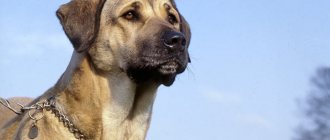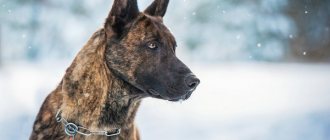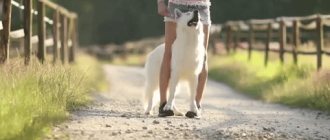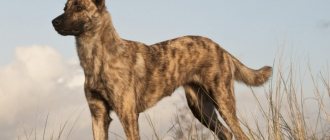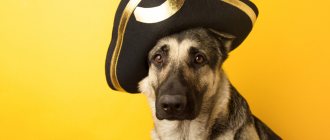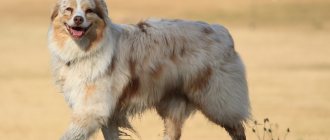Brief historical background
The history of the Icelandic Shepherd is rather vague. It is believed that their ancestors were the ancient Scandinavian Spitz-shaped dogs, which came to the territory of Iceland around the 9th-10th centuries. At first, the animals helped their owners in the hunt, but then, due to the lack of a large amount of game, they retrained as shepherds, expertly using the scent to find missing ones, strays from the herd, and stray sheep.
The appearance of the Icelandic dog has not changed for hundreds of years
Since then, the Icelandic Shepherd Husky has existed almost unchanged, because very few foreign dogs were brought to the island. An epidemic of an unknown disease that occurred in the 19th century, which first affected sheep and then spread to their four-legged shepherds, destroyed almost the entire livestock, as a result the breed was on the verge of extinction. The government took up its revival, issuing a decree in 1901 banning the export of representatives abroad.
Gradually the number of animals increased, in 1972 recognition was received by the world canine community, and at the same time the first breed standard was described. In the FCI registry, the Icelandic Sheepdog is included in group 5 “Spitz and dogs of a primitive type” (section 3 “Scandinavian guard and herding dogs”) under number 289. The last updated and current standard dates back to June 20, 2007.
Now the Icelandic Spitz is not in danger of extinction, but their numbers are small - about 16 thousand individuals.
Content
History has left its mark, making it much more difficult for an Icelandic dog to adapt to urban living conditions. Living in a city apartment does not allow her to use her potential, so the animal begins to experience stress.
But the outdoor working environment and active, constant work are a breath of fresh air for her. For this reason, it is advisable to keep this breed on a farm, a private house, and where it can find free territory and a favorite pastime. If the dog lives in an apartment, it should take walks at least 1.5-3 hours a day.
The Icelandic guard dog is not afraid of precipitation, hot temperatures and frost. Wool protects it in the cold season, and in the summer - from heat and direct ultraviolet rays. In order for the wool to get wet to the skin, you will have to try hard.
Description of the Icelandic dog
Currently, Icelandic Shepherds can still be found on pastures in remote areas of Iceland, where they carry out their direct duties - herding sheep. They are used extremely rarely for hunting, but occasionally they help in the search for missing people and animals, and also perform guard functions. However, most often shepherd huskies are kept as companions and family pets, actively participating in all kinds of dog competitions and exhibitions.
Breed standard
The Scandinavian Shepherd is a well-built, lean, Spitz-shaped dog, slightly below average height, with a strong, slightly squat bone structure and well-developed muscles. A compact body of a stretched rectangular format with a flat, strong and muscular back, a not very long, wide, sloping croup, an elongated, deep, widened sternum and a slightly tucked belly. Males are noticeably more powerful and larger than females.
The Icelandic Shepherd is a small, but well-cut and compact dog.
Breed standard:
- A strong wedge-shaped head with a dome-shaped skull and a triangular muzzle tapering towards the nose, slightly longer than the skull, set on a high, curved, moderately long neck (without dewlap). The stop is clearly expressed.
- The nose is pigmented black or dark brown (in dogs with cream and chocolate coats).
- Jaws in a scissor bite with a full set of teeth. Black or dark brown lips fit tightly.
- The almond-shaped eyes are small with black eyelids. The iris is dark brown in color; in cream and chocolate individuals it is slightly lighter (brown eyelids). The look is smart, cute, cheerful and happy.
- Ears with rounded tips, triangular, erect, small, well express the mood of the animal, sensitively reacting to all sounds.
- Muscular, even, parallel legs, oval paws with arched, strong toes, tightly knit, and elastic pads.
- The high tail is curled into a ring and thrown over the back.
- Height at the withers (ideal): for bitches - 42 cm;
- for males - 46 cm.
The Icelandic Shepherd moves confidently and energetically, all movements are dexterous, light, very hardy and productive.
Features of the coat
The coat is very dense and thick, two-layered. There are two types of wool:
- Short coat, consisting of a rather coarse guard hair of medium length and a delicate soft undercoat. On the neck and chest the hair is longer, forming a collar, on the hind legs there are feathers, and the tail is well feathered. Shorter hair on the front legs and head.
- Long coat of roughish guard hair and thick soft down. Long hair on the back of the ears, chest and neck, feathering on the limbs, short hair on the top of the head, on the muzzle, as well as on the front of the ears and legs.
The Icelandic Shepherd's coat can be quite short.
The standard allows the following dominant colors:
- grey;
- black;
- all shades of red (orange);
- chocolate brown.
The main predominant tone is always followed by white markings (on the head, chest, limbs, tail). The fur on the belly and the entire lower part of the body, including the bottom of the tail, is a lighter shade. Individuals with light fur (gray and red) have a dark mask on their muzzle. Dogs with a dominant black coat have a tricolor color; along with the traditional white spots, there is a red tan on the paws, cheekbones, and characteristic eyebrows above the eyes. Variegated colors are allowed, when there are multi-colored spots on a white background.
Disadvantages and disqualifying characteristics
A defect is any deviation from the breed characteristics, its severity is assessed based on the degree of severity, as well as its effect on the well-being and health of the animal. Disadvantages include a black back in red dogs or solid black coloring (no spots).
The vices are:
- bulging or round eyes;
- yellow iris;
- absence of dewclaws.
Individuals with obvious mental, behavioral or physical disabilities are subject to disqualification.
Wool
The characteristics of the Icelandic dog regarding the “coat” should be as follows:
- short or long cover;
- thickness and resistance to water;
- the outer layer of wool is densely planted;
- the undercoat is softer and denser;
- paws, ears, skull and muzzle have much shorter fur than the rest of the body;
- the longest hair grows on the back, neck, hind legs and chest;
- the tail is quite fluffy;
- By the type of “coat” you can distinguish a male from a female.
Character of the breed
The herding Icelandic husky has a very cheerful, playful, sociable and inquisitive character . The breed is people-oriented, boundlessly attached to its owners, constantly following on their heels and spinning under their feet, in need of communication. A vigilant and fearless shepherd dog performs good guard duty, clearly controlling the territory entrusted to it. He enjoys using the excellent vocal abilities endowed by nature, barking loudly at the slightest provocation. The hunting instinct is rather poorly developed.
The Icelandic Spitz protects the controlled territory well
Peace-loving dogs never show aggression, trying to avoid conflict . They get along well with other pets, seeing them as their flock in need of protection. Even cats are rarely chased, and even then out of pure sporting interest, physical harm is never caused to them. This Spitz has the most trusting and sincere relationships with children; the dog’s patience is almost inexhaustible.
A friendly and good-natured shepherd greets strangers kindly, without the slightest drop of aggressiveness. There is a special prejudice against all birds, which is explained by the need in the past to protect ward lambs from birds of prey attacking from the air. A dog can meaningfully and for a long time look for someone in the sky, lifting its head upward.
History of the origin of the species
The first mention of the ancestors of the South Russian Shepherd Dog is usually attributed to 1797. At the end of the 18th century, at the state level, the task was set to organize sheep breeding in the undeveloped territories of the Tauride steppes. For this purpose, fine-wooled Spanish sheep were brought to the region of modern Zaporozhye and Kherson region. Along with the flocks, special shepherd dogs – small Asturian Shepherd Dogs – were also brought to the Russian Empire.
However, representatives of this breed could not provide practical assistance to local sheep farmers. The animals were well trained to maintain order in the herd. But in the conditions of the southern, scorching heat, and in the absence of water, they were unable to cope with the main task. Being short and relatively weak in build, they were unable to protect their herds from steppe wolves.
There was a need to create a different type of powerful guard dog that would also have exceptional herding qualities. Thus, the idea of crossing imported individuals with local breeds - Tatar Shepherd Dogs and Greyhounds - appeared. The result of selection was the South Russian Shepherd Dog. Combining the strength and endurance of the first breed, and the tall stature and viciousness of individuals of the second species, the dog became an unrivaled guard.
The main distribution area of the South Russian Shepherd was Crimea. The main selection work was carried out in the large estate of Askania-Nova, located in what is now Ukraine. The documentary archive of this estate, which has survived to this day, confirms that it was here in 1856 that the largest number of individuals was recorded.
The Civil War made adjustments to the development of the breed, and the number of dogs was greatly reduced. The individuals that survived on the farms of individual shepherds and ordinary fans of this breed became the basis for restorative breeding. It was organized in the city of Dzhankoy with the support of the state. In general, the nursery staff successfully completed the task. In a short time, lines were bred that were not inferior to specimens brought from the territory of Askania-Nova and from other cities of the country.
Choosing a puppy and its cost
Buying a small Icelander is not easy, since there are literally only a few of them in our country. For a puppy, it is better to contact specialized nurseries located in Denmark, Sweden, in their homeland of Iceland or in the USA. A conscientious breeder will definitely provide the necessary set of documents (parental pedigrees, puppy statistics, etc.) proving the fact of the pet’s thoroughbred.
The cost of a puppy can vary from 30 to 35 thousand rubles, depending on the status of the nursery and the prospects of the baby himself.
It is not recommended to buy dogs offered through advertisements or by hand, since purebred Icelandic Shepherds are often passed off as different crossbreeds with huskies. Only an experienced dog handler can distinguish them visually.
It is almost impossible to find an Icelandic dog puppy in our country
History of the origin of Australian Shepherds
To everyone's surprise, Australian Shepherds do not come from Australia, but from the United States of America. The breed was formed in the Western United States in the 19th-20th centuries.
The dogs' ancestors were:
- The Pyrenean Shepherd is a breed of herding animal native to the North of Spain and the South of France. Distinctive features: long hair and medium body size;
- Appenzeller Mountain Dogs are shepherd dogs that were bred in the northeastern part of Switzerland. The purpose of animals is shepherding. Distinctive features: short and spotted (black-white-red) coat, drooping ears (to the cheeks), flat eyes, straight tail, medium size;
- Collies are Scottish cattle dogs. The exact species that became the ancestors of the Aussie are unknown. But from this breed the Australian Shepherd took thick hair, shaggy paws and wide eyes.
The animal was bred for one purpose - to help shepherds when walking sheep, cows and other livestock. The resulting dogs exceeded all the expectations of their creators. Aussies tolerate any climatic changes well, are active, easy to train and flawlessly follow the commands of their owners.
Cowboy Jay Sisler played a major role in popularizing animals. It was he who was one of the first to acquire an Australian Shepherd without a pedigree, thanks to her he became interested in breeding this breed and made it famous everywhere. Representatives of Aussies gained worldwide popularity through television (broadcasts of rodeos and horse shows).
Why then are dogs called “Australian”? It's simple - some of their ancestors were brought to the USA from Australia. Scientists attribute this migration to World War II and the Gold Rush. The second name of the animals (Aussie) is explained even more simply. This is what Americans call everything Australian.
Features of care
Icelandic dogs are completely unpretentious in grooming.
Hygiene
The complex of hygiene measures includes:
- weekly combing to prevent the formation of tangles (more often during active molting);
- water treatments 1–2 times a year using zoo shampoos;
- examination of the ears and eyes once every 5–7 days, cleansing of secretions using a veterinary lotion, herbal decoction, etc.;
- shortening the claws, if they do not grind down themselves, using a nail clipper;
- brushing teeth once every 7–10 days with a special toothpaste for animals and a finger brush.
Walk
Active and energetic Spitz dogs need long (2-3 hours) daily walks, where they can satisfy their thirst for movement. This breed is suitable only for active people who can provide their pets with the proper level of physical activity, taking them with them on bike rides, morning runs in the park, trips to the mountains, trips to nature and other outdoor activities.
Icelandic Spitz needs to exercise a lot
Nutrition
Owners usually try to feed native dogs home-cooked, freshly prepared food, but store-bought freeze-dried food is becoming increasingly popular. Experienced dog breeders advise choosing products of at least a premium class, intended for active and active dogs:
- Hill's Science Plan Performance;
- Royal Canin Sporting Life Trail 4300;
- Purina Dog Chow Active;
- Pro Plan Adult Performance.
Pro Plan Adult Performance is designed for adult dogs with particularly high levels of physical activity.
The natural diet consists of:
- sea fish without bones or minced fish;
- lean meat (veal, rabbit, etc.);
- offal (trimmings, tripe, kidneys, etc.);
- seasonal vegetables and fruits, herbs;
- eggs;
- fermented milk products with reduced fat content (ryazhenka, cottage cheese, etc.);
- cereals (buckwheat, millet, etc.);
- vitamin and mineral supplements.
It is forbidden to give shepherd dogs pasta and bakery products, smoked meats, sweets, as well as fatty foods and hollow tubular bones.
Feeding
These animals are ready to eat whatever their owner prepares for them. It is important not to give too much food and follow a certain feeding schedule. For an adult, two meals a day is enough. Food should not contain a lot of fat, be balanced, rich in minerals and vitamins.
Veterinarians advise feeding the animal after a walk. The diet should contain by-products, fruits, cereals, meat, vegetables, dairy products and boneless sea fish. After eating, the animal must rest for some time, otherwise intestinal volvulus may occur.
Health
The Icelandic Sheepdog has good health, tempered by the harsh climate of its homeland.
Life in harsh climatic conditions and natural selection did their job, providing the Icelandic watchmen with excellent health and a strong immune system. No dangerous hereditary predispositions were found in them. A Spitz from Iceland can live for about 12–14 years.
Icelandic Shepherds need to be vaccinated regularly (once a year) and dewormed (once every six months). Measures to protect against ticks and fleas (collars, drops, etc.) are necessary.
Mating
- To properly breed shepherds, it is necessary to take into account the frequency of mating. It is advisable to breed females through estrus, once a year. Frequent matings are also not recommended for males so that their offspring are healthy and of high quality.
- The first time to breed an English Shepherd bitch is at the age of one and a half years. A similar age is suitable for males. At the same time, breeders do not advise breeding two inexperienced animals.
- Two weeks before mating, both dogs must be dewormed. In addition, owners should treat their pets for fleas and take preventive measures against ticks. Only healthy animals that have received all the necessary vaccinations are allowed to breed.
Training and education
Herding huskies' ability to learn and train is at the highest level; they instantly remember commands, and then willingly and joyfully carry them out . A smart and intelligent pet can be easily taught various rather complex tricks. Shepherd dogs take an active part in dog competitions (freestyle, fly-ball, agility, etc.).
After eight months, the puppy is recommended to undergo a general training course (GTC).
The Icelandic Sheepdog can take part in various dog competitions
It is extremely important to wean the puppy from “vacuuming”, that is, collecting on the street and eating all sorts of goodies, in his opinion, that could turn out to be deadly. One of the first commands to learn is “fu” or “no”. Our dog had this bad habit until his old age, but at the word “ugh” he immediately opened his mouth and dropped what he had picked up.
Nutrition
The main rule of feeding a Swiss Shepherd, in principle, like other pets, is regularity, balance and completeness. For an adult dog, one meal in the morning and one in the evening will be enough.
Puppies should receive food at least four times a day, and from six months - three times. If the animal lives in the house, it is better to place the bowl not in the kitchen, but next to it - this is part of the upbringing from the point of view of the family hierarchy in the eyes of the pet.
The serving size should be designed for one meal so that the dog does not overeat. And in the cold months of the year, if the animal lives in a private sector, you need to slightly increase the portion.
For BShO, it is allowed to feed only premium dry food or use a mixed type. Although it will be more difficult to properly structure a diet of natural food, it is more beneficial for a Swiss Shepherd.
When choosing ready-made food, you need to select the manufacturer and type of product individually for each dog. If this is not done or a low-quality product is given, many health problems can arise: from allergies and urolithiasis to tumors.
Every day an adult should receive about 0.5 kg of meat. It is best to choose lean meats, such as chicken and other poultry, rabbit or beef. You should not feed your animal bones as it may choke. Fish should also be present in the diet (both river and sea species are suitable), but in this case the owner must be especially attentive to the absence of bones.
The shepherd dog eats many types of porridge (buckwheat, rice, millet, etc.) as a side dish with pleasure. They need to be boiled in unsalted water with the addition of one tablespoon of high-quality oil. Bone meal and fish oil are also welcome in the diet.
However, the diet will not be completely balanced if you do not add eggs (three pieces a couple of times a week), fermented milk products (milk, kefir, yogurt and cottage cheese). BShOs are also very fond of various vegetables and even some fruits (for example, apricots, raspberries).
White Swiss Shepherd is a very beautiful dog
There should always be water in the dog’s bowl; it should be changed at least every other day. In addition, adding vitamins, minerals, special complementary foods and treats to the diet will also not be superfluous. They should be chosen according to the age of the pet and the advice of the veterinarian.
Appearance
Due to the non-recognition of the Tuvan Shepherd Dog by the ICF, there is no official description of the breed, therefore the standard is conditional and is taken into account by specialists during breeding. So, the Tuvan Shepherd is a fairly large animal: the height of a male at the withers reaches 60-70 cm, and that of females reaches 58 cm. The weight ranges from 38 to 50 kg for males and from 30 to 40 kg for females.
The breed is characterized by a head that is proportional to the body, a wide, drooping chest and a tucked belly. Brown eyes are not too large and have an oval shape, the nose is quite wide with a large lobe, the lips are dark in color and pressed tightly to the jaw. The ears are triangular in shape and set high, the teeth are quite large, with a regular bite and a full set of canines.
The dogs are distinguished by a wide, strong neck, a loose loin and a straight back. The paws are straight and strong, forming a dense ball, the claws are strong, painted black. The tail is elongated, low set and densely covered with hair.
The animals' fur is very elastic and thick, forming a clearly visible mane in the area of the withers and neck. The undercoat is quite dense, but at the same time soft and light. Behind the ears and on the tail, the hair often mats, forms “earrings” and looks unkempt.
The color of the Tuvan Shepherd is predominantly black, but sometimes the chest and paws can be covered with white spots. Even less common are white representatives of the breed, whose body is covered with large black spots, and the lips of such individuals are often spotted. In addition to white and black colors, brown, sable and even gray with large white spots are sometimes found.
Best nicknames
Abroad, male Icelandic Shepherd puppies are called Basti, Kniff, Vinsett, Dayron, Vesamont, Brusik, Lauren, Alfred. For girls, the nicknames Zukhra, Malibu, Melena, Gafa, Ailanta, Zhunya, Indy were invented.
Dogs of any breed that are liked by their owners will always be the most beloved, despite all their shortcomings. But dogs of the Icelandic dog breed have practically no disadvantages, except for two - they cannot be bought in Russia and they bark very loudly and loudly.
But the dogs have a unique character. They are friendly, sociable, easy to train, love people, and with proper upbringing they completely obey their owner. Probably many would like to have such dogs.
*Prices are current as of December 2022.

